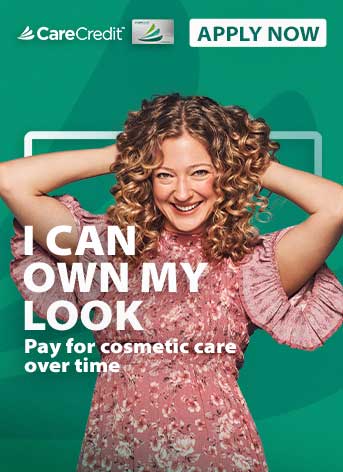Looking to lift your cheeks, smooth out old acne scars or add a little fullness to your face? Dermal fillers might be the fix. As we get older, our skin can thin — this can make lines more pronounced, features less defined and areas like eyes and lips look sunken from sagging skin and aging facial muscles. From plumping to smoothing, shaping to softening, dermal fillers can be used in a variety of ways and areas to reshape, restore and refresh.
What are Dermal Fillers?
Dermal fillers are a category of different gel-like solutions that are injected under the skin to plump, contour, soften and enhance features depending on the area and the desired results.1
Dermal fillers may also be referred to as wrinkle fillers, soft tissue fillers or injectable fillers.2
Where Can Dermal Fillers Be Used?
Though they are sometimes thought of as just “wrinkle fillers," dermal fillers can be used in a variety of ways to lift, plump and reshape the face and body.
Here are some of the most common uses for dermal fillers:1
- Cheeks: used to restore or increase the volume around the cheeks
- Lips: reduce vertical lip lines, as well as plump and define the lips themselves
- Mouth: smooth "marionette" or smile lines around the mouth
- Eyes: used by the brow line to lift and restore volume to the temple. They can also be used to smooth tear troughs under the eye
- Forehead: smooth brow furrows (sometimes called "the 11 lines") or frown lines
- Nose: reshape the nose or soften nasolabial folds
- Hands: rejuvenate and plump
- Chin: contour or smooth
- Acne: help lift and smooth recessed scarring
Types of Dermal Fillers
So which dermal filler is right for you? It depends. According to the American Board of Cosmetic Surgery, "Each [dermal filler] is uniquely formulated to have a certain texture, density, and injection depth, which means that certain fillers work better for certain areas of concern."1
Softening lines around the eyes will call for a different filler than one that can build structure to enhance cheekbones.
Some of the most common types of dermal fillers include:
Hyaluronic Acid (HA)
- What it is: A naturally-occurring substance found in our soft connective tissue, joints and skin.
- Uses: Lifts and plumps scars and skin depressions due to acne or injury, smooths wrinkles around the eyes, forehead, or lips, and plumps and reshapes lips.
- Benefits: The soft, gel-like texture of this dermal filler makes it a good choice for subtle results in highly visible areas of the skin. Lasts six to 12 months.1
- Brands: Juvéderm® (Juvéderm XC®, VOLUMA™, VOLBELLA®, VOLLURE™), all Restylane® fillers, Belotero Balance®, Revanesse Versa, RHA fillers.5
Calcium Hydroxylapatite (CaHA )
- What it is: A mineral compound found naturally in our bones.
- Uses: Corrects moderate to severe wrinkles and lines such as nasolabial folds, marionette lines and frown lines.
- Benefits: A thicker dermal filler making it better suited to filling deeper lines and able to last longer — roughly 12 months for many patients.
- Brands: Radiesse®.5
Polylactic acid
- What it is: A non-toxic, biodegradable synthetic dermal filler that plumps lines by stimulating the body to produce and rebuild collagen in the area.
- Uses: Plumps deeper lines and wrinkles around the nose, mouth and cheeks.
- Benefits: Subtle sculpting. Since polylactic acid is designed to stimulate your body's own collagen production, the results appear gradually over a few months. You will likely need monthly treatments over the first three to four months, but then should see semipermanent results.
- Brands: Sculptra®.5
Polymethylmethacrylate (PMMA)
- What it is: A semi-permanent synthetic substance comprised of collagen and tiny microspheres that provide continual lift and support.
- Uses: Fills medium to deep lines, wrinkles and furrows; lifts pitted scars; plumps lips.
- Benefits: Considered a semi-permanent dermal filler, PMMA can provide long-lasting results than some other fillers
- Brands: Bellafill®.5
Polyalkylimide
- What it is: A stable, semi-permanent gel-like dermal filler that when injected, encourages a layer of collagen to form around it.
- Uses: Treats deeper wrinkles; enhances cheekbones and jawline; plumps lips.
- Benefits: A single treatment can create semi-permanent results and can be removed if necessary.
- Brands: Aquamid®.5
How Long Do Dermal Fillers Last?
How long a dermal filler will last depends on the specific filler used, as well as the area that is being treated.1 Hyaluronic acid dermal fillers are usually the most temporary, lasting six to 12 months. Synthetic dermal fillers like polylactic acid are longer lasting as they are not absorbed by the body.1 Where a dermal filler is used can also impact how long it lasts. Hyaluronic acid filler in the lips will dissipate faster than the same filler used in the lines around the mouth.1 Be sure to talk with a qualified dermatologist or cosmetic surgeon to understand the best dermal filler for your needs and how long you can expect it to last.
Risks and Side Effects of Dermal Fillers
As with any cosmetic procedure, dermal filler can have the potential for risks and side effects. Common side effects from the procedure itself can include bruising, redness, swelling or infection at the site of the injection.2 Some fillers such as those made with polymethylmethacrylate may be visible under the skin and lead to lumps, bumps or asymmetrical results. Others, such as those made with hyaluronic acid, may only offer short-lived results and will require regular treatment for continued results.6 Although rare, one of the more serious complications is when dermal fillers are accidentally injected into a blood vessel which can lead to a blockage in the blood vessel.1
Dermal Fillers Cost
The cost of a dermal filler treatment depends on the specific filler as well as the volume injected. Geographic location and qualifications of the provider may also impact the price. Below is the average pricing per-syringe of various dermal fillers based on recent statistics from the American Society of Plastic Surgeons.8 Note that many treatments require multiple syringes to achieve the desired results.
- Calcium hydroxylapatite: $717
- Hyaluronic acid: $684
- Polylactic acid: $853
- Polymethylmethacrylate: $1,058
What Dermal Fillers Can't Do
While dermal fillers are very versatile, they do have limitations. For some reshaping and lift results, treatments such as an eye lift or full face-lift may be a better fit for your needs.3 It's also important to remember that dermal fillers are a temporary treatment and regular treatments will be required for continued results. It is best to meet with a qualified plastic surgeon who can address your areas of concern and suggest the best treatments to achieve your desired results.3
Botox® Cosmetic vs. Fillers
Dermal fillers are also different from wrinkle relaxers like Botox® Cosmetic. Dermal fillers lift and plump the skin in areas where depressions are not caused by muscle contractions. Treatments like Botox® Cosmetic work by temporarily relaxing muscles in areas like the eyes and forehead that regularly contract and cause lines and wrinkles.4
How to Find a Dermal Filler Provider
Depending on the specific procedure desired, dermal fillers may be available at a plastic surgeon's office, a dermatologist or at a medical spa. Be sure to check out a provider's training and qualifications as well as before and after photos of the specific procedure you are considering.7 Search for a provider that is board-certified by the American Board of Plastic Surgery which is recognized by the American Board of Medical Specialties.
Although dermal fillers and other injectables may be a less invasive procedure than a face lift, it is still a medical procedure that requires a qualified and experienced medical professional.7
CareCredit Financing for Dermal Fillers
Dermal fillers often aren't covered by insurance, but using the CareCredit credit card is one way to help finance the costs of cosmetic procedures like injectable filler treatments*. Use our Acceptance Locator or download the CareCredit Mobile App to find a dermal filler provider near you who accepts the CareCredit credit card.
Author Bio
Kate Bayless is an experienced health and wellness freelance writer with 15 years of experience. Her work has appeared in Parents, Women's Health, Beachbody, and OpenFit.








